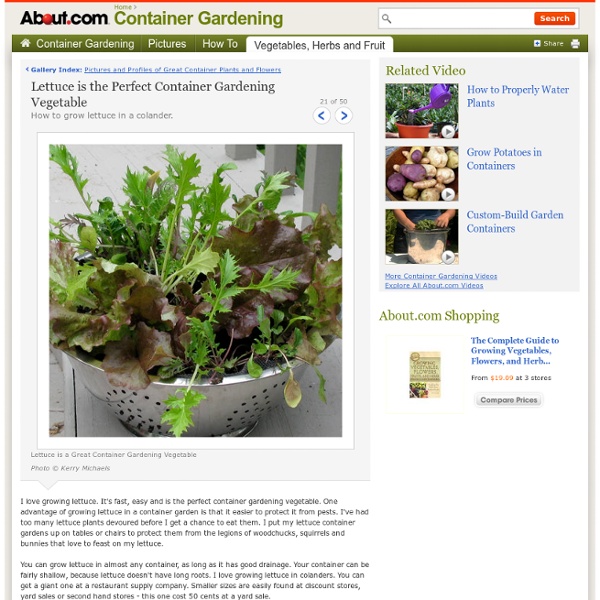Container Gardening Vegetable - Lettuce is the Perfect Container Gardening Vegetable
I love growing lettuce. It's fast, easy and is the perfect container gardening vegetable. One advantage of growing lettuce in a container garden is that it easier to protect it from pests. I've had too many lettuce plants devoured before I get a chance to eat them. You can grow lettuce in almost any container, as long as it has good drainage. You do have to be careful with any metal container, in the blistering hot sun because they can get hot and cook your plants root system. Here's what you need to make a lettuce container garden in a colander: SunColanderPotting soilPlastic window screeningFertilizerLettuce seed or seedlings 1. 2. 3. 4. 5. 6. Great lettuces to try in container gardens: Black Seeded Simpson (heat tolerant)Simpson Elite (heat tolerant)Tropicana (heat tolerant)Elegance Seed Mix, from Johnny's SeedsMesclun mixes
One Glassy Garden: Growing Herbs in Mason Jars | Kitchen Garden
Forget the usual terracotta and (ugh!) plastic pots for container gardening. When you grow herbs in mason jars, you can have garden fresh ingredients on hand and also add some style to a sunny windowsill. Picture a row of mason jars filled with different herbs—basil, chives, parsley, cilantro, thyme, rosemary—dressing up your kitchen. Pretty, right? The clear glass allows you to see the herbs’ rich root structure growing through the soil. With the right conditions—ample light and proper drainage—most herbs are extremely easy to grow, and growing them in mason jars is no different. 1. 2. 3. Finally, add some labels so you won’t forget what you planted! You diy, recycling junkies could also use pasta jars, pickle jars or whatever other glass container you come across for this project. image: B_Zedan
Soda Bottle Carrots
Seventeen days after I planted carrots in a sawed-off soda bottle, young carrot tops had sprouted on the windowsill in my basement. I encourage people who have little space that they can still grow small kitchen gardens. To that end, on May 1st I cut the top off of a two-liter soda bottle, filled the bottle with soil, and planted carrots in it. I described this project in a post titled Small Kitchen Garden Carrots in Containers. I mentioned my container carrots again on May 18, and again on June 17. It has been an interesting project, and I encourage you to try it. Mature Container Carrots After three months of growing, a carrot of nearly any variety should be mature. After three months of growth, my container carrots have pathetic tops. So, my container carrots—a variety that matures in 65 days—ought to be dropping seeds all over my deck. The good news is that those sickly-looking carrot tops protrude from very pronounced orange carrot shoulders. Pushing Plants If I don’t?
Urban Agriculture: A Guide to Container Gardens
A Guide to Container Gardens With inexpensive containers and suitable soil mix,you can create an urban garden virtually anywhere - on roof tops,vacant city lots, borwn fields, and unused portion of parking lots Job S. Ebenezer, Ph.D.President, Technology for the Poor, 877 PELHAM COURT, WESTERVILLE, OHIO - 43081technologyforthepoor@yahoo.com It is estimated that by 2030 AD nearly 50% of the world’s population may live in urban areas. Due to the recent terrorist attacks, food security and safety are seriously compromised. Migration from rural areas also brings into the urban areas many persons with very little formal education. Urban agriculture has the potential for creating micro-enterprises that can be owned and operated by the community members without too much of initial capital. Urban farming is not new. A few decades ago ECHO (Education Concerns for Hunger Organization) in Fort Myers, Florida, has introduced container garden techniques for impoverished counties like Haiti.
Related:
Related:



